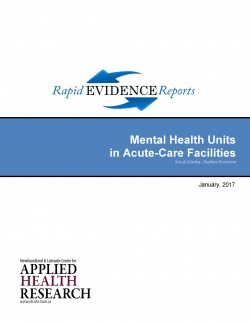NEW! CHRSP study on mental health units

REPORT HIGHLIGHTS:
“What does the scientific evidence tell us about the appropriate physical and therapeutic features of acute-care mental health units that best support the quality of care and the safety of patients and staff in a recovery-oriented therapeutic environment?”
The findings from the literature were organized into the following categories
- Overall Architectural Features
- Access to Nature and Light
- Interior Design, Materials or Features
- Nursing Stations
- Patient Rooms
- Family Rooms
- Locked Versus Unlocked Units
- Sensory Modulation
- Seclusion Rooms
Key findings include, but are not limited to, the following:
- Research on evidence-based design for health facilities is a relatively new and emerging field of study; this is especially evident where mental health facilities are concerned. To date, most of the research in this area is of limited scientific quality. As a result, studies are rarely able to draw any causal links between physical or therapeutic features of the environment and outcomes for staff and patients. Some of the best advice currently available can be found in ‘guides’ that are based only indirectly on systematic syntheses of the existing evidence and expert opinion. For robust, evidence-based decision support on these issues, more research and better research design will be required.
- There is a widely recognized need to move away from asylum-style architectural design of mental health spaces in favor of familiar, home-like environments suitable for healing and recovery. Ideally, such facilities would enable the provision of healthcare in a pleasant, comfortable and safe environment while also facilitating better mental healthcare.
- One special consideration that the research we have examined makes clear is that mental healthcare facilities are intrinsically different from general healthcare facilities—these inherent differences should be the lens through which any design decisions are made in an effort to produce safer, more therapeutic, and more recovery-oriented mental healthcare environments.
- The unique safety issues that arise within mental healthcare settings are such that nurses have to juggle the often-conflicting requirements of technical safety with those of providing recovery-oriented patient care. Patients may regard what nurses see as safe treatment as being counter to their need for autonomy and privacy. Two common areas in the literature that allude to such differences in staff and patient perceptions of physical components of the environment involved in safety are locked versus unlocked units and the design of nursing stations. In some cases, it is possible that these perceptions are related to the process of care or the model of care rather than to the physical environment. This is a distinct body of literature outside the scope of this review that also requires consideration.
- Patients in mental health units are not a homogenous group. Therefore, physical and therapeutic design elements should reflect the needs of specific categories of patients. Different individual patients may also have different reactions to environmental features or have different definitions of what is meant by a home-like environment.
The authors, Sarah Mackey and Stephen Bornstein wish to acknowledge the contribution of our consultant for this report, Sarah Jarmain, MD, FRCPC, Site Chief of Mental Healthcare, Chair of the Medical Advisory Committee, and Director of Medical Quality at St. Joseph’s Healthcare, London ON and an Associate Professor in the Department of Psychiatry at Western University. Dr. Jarmain provided invaluable guidance in the preparation of this study.
Your feedback on this report is both welcome and appreciated. Please contact sarah.mackey@med.mun.ca if you wish to review the findings from this report in greater detail.